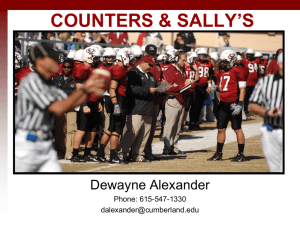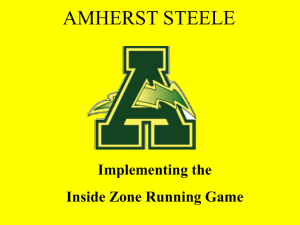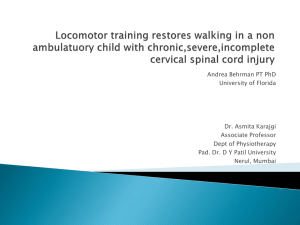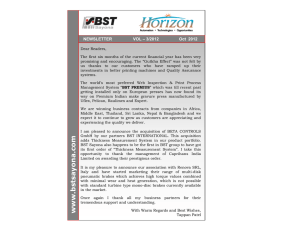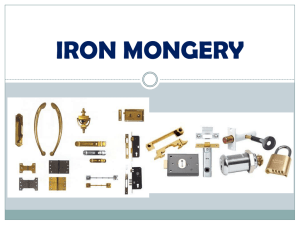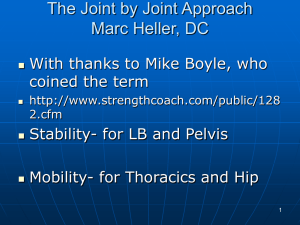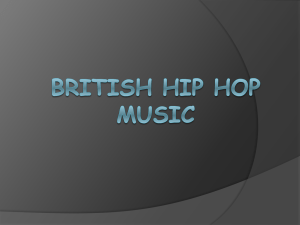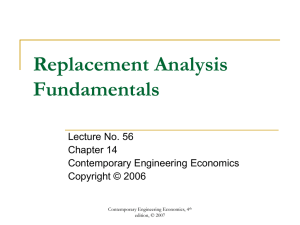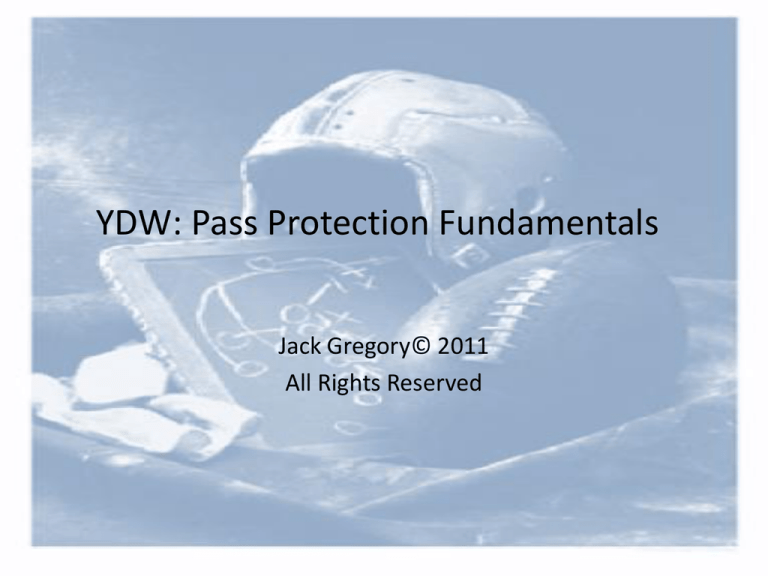
YDW: Pass Protection Fundamentals
Jack Gregory© 2011
All Rights Reserved
Elements of A Successful Passing Game
• In order to have an effective passing game you
have to have a good passer, good receivers, and
good pass protection.
• When it comes to pass protection I am not
concerned with my line faking run or pulling. I
am concerned with the play being successful and
a major portion of that is protecting the passer.
• I let my eligible players fake and misdirect as my
line protects to further mask/delay the pass rush.
QB Action in the Passing Game
• Drops (in the power game often there is action behind and in front
of the QB so even if he is dropping the play appears as if it is a run)
– Quick set
– 3 step
• Play Action (passer sells run)
– Fake and drop
• Roll/Bootleg
– Roll out flow side
– Bootleg back side
• Gun
– Quick set/3 step = quick set
– Play action = fake and quick set
– Roll/Bootleg = same action a little more depth
Levels of Pass Protection
• Pass protection is broken into two levels of
protection.
– Basic pass protection which is built off our wedge
run blocking scheme - we use it for drop back and
roll out type plays against basic defenses that are
young and inexperienced.
– Advanced set of protection schemes for older
teams and more advanced defenses that are well
coached.
Wall Schemes (Basic)
• Wall – is simply a wedge scheme with the center firing out
to create vertical movement so the rest of the line can
mesh. This basic concept eliminates inside penetration and
the backs are responsible for sealing/walling out the edge
defenders. The reasoning behind this is pretty simple often
the best rushers are often on the edge and offensively our
best athletes are in the backfield so obviously the best
match up is linemen protect the interior and athletes
(backfield) protect the edges.
• Dash – is wall protection with the backs walling in the edge
defenders on the play side so the passer can get outside.
Wall (Quick Set/3 Step Drop)
Wall
•
•
•
•
Same as wedge with no vertical movement.
Center takes two vertical steps and sets.
Guards slide and mesh hips together. No one gets through inside.
Tackles slide right under guards and mesh top of hip to backside of
guards. No one gets through inside.
• If PSTE staying he slides under tackles in the same manner as the
tackles under guard. No one gets through his inside.
• BSTE if staying will hinge under BST and mesh his inside hip to the
backside of the BST. Let no one inside.
• If the BSTE is hinge blocking the BB will wall off the outside under
the last blocker on the WALL. If the BSTE is not hinge blocking the
BB will wall off the backside in the same manner. We always
protect the backside of the passer first. Passer is responsible for
play side pressure since he sees it coming.
Dash (power/roll)
Dash
•
•
•
•
Same as wedge with no vertical movement.
Center takes two vertical steps and sets.
Guards slide and mesh hips together. No one gets through inside.
Tackles slide right under guards and mesh top of hip to backside of guards.
No one gets through inside.
• If PSTE staying he slides under tackles in the same manner as the tackles
under guard. No one gets through his inside.
• BSTE if staying will hinge under BST and mesh his inside hip to the
backside of the BST. Let no one inside.
• Depending on play you will have one or two backs that will pin and wall in
the edge defenders. The first back will always attack the first defender on
the outside hip of the last blocker on the wall. He will attack the outside
arm pit and wheel his butt outside and wall the defender inside. If there is
a second back he will go under and outside of the first back and execute
the same move on the next defender to show.
Sprint (advance power/roll)
•
•
Advanced pass protection
In the Sprint scheme (Figure VII-F), if the center is uncovered and no backer is over, he will hinge (HHM) with butt
facing the passer. Block from play side hip to away hip helping the wall guard first if needed. If covered or the
backer over is a threat to blitz, or the WALL GUARD needs help he will LEM.
•
Wall guard will LEM if covered; if uncovered they will SSM towards the wall tackle and double with wall tackle if no
other defender shows.
•
Wall tackle will LEM if covered; if uncovered he will SSM to the next defender outside (this often means he will
double the defender that the RB is logging (walling inside).
•
Pull guard he will hinge (HHM) with butt facing the passer; block with inside out priority. He will stay glued to the
near hip of the center and bit deeper.
•
Pull tackle he will hinge (HHM) with butt facing the passer; block with inside out priority. He will stay glued to the
near hip of the pull guard and a bit deeper.
•
Pull tight end he will hinge (HHM) with butt facing the passer; block with inside out priority. He will stay glued to
the near hip of the pull tackle and a bit deeper. The pull tight end might not be involved in the pass protection if
he is involved in the pass pattern.
•
•
RB (either BB or BSWB [TB]) will cross over and log (wall in) the first defender on the outside hip of the wall tackle.
As you cross the QB’s face, flash fake the hand off to hold the LB’s in place so the receivers have more space to
operate and slow the initial pass rush. This makes everyone’s job easier.
LEG Modification
• LEM: LOAD – EXPLODE – MIRROR (covered)
• SSM: SLIDE – SLIDE – MIRROR (uncovered)
• HHM: HINGE – HINGE – MIRROR (sprint away)
Making the Block on the Edge
Four Points of contact on the DEMLOS:
1) The PSTE must release through the
nearest shoulder and his near hand
should punch and push him back as he
releases to slow his rush.
2) The BB should release across his face
and his up field shoulder should rub the
chest of the DEMLOS to slow his rush.
3) The PST should SLIDE SLIDE MIRROR the
DE and if he needs to give ground in
order to maintain his mirror he does so.
4) The WB gains enough depth so tht he
can attack the outside arm pit and seal
the DE inside so that the WB’s butt is
facing the perimeter.
Back side pressure:
BST if uncovered will HINGE, if
covered he will LOAD, EXPLODE,
MIRROR.
BSTE will always HINGE
OVER the BST and you
add an additional
blocker to the play side
(LEM if covered/SSM if
uncovered)
Tight Rip Power Pass Right
Questions/Comments?

